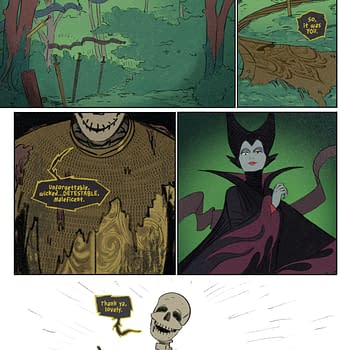Posted in: Comics | Tagged: comichron, john jackson miller, marvel, Rich Johnston, sales, tom brevoort
Marvel's Brevoort: Publicly Available Comic Book Sales Estimates Not "Remotely Accurate"
Marvel recently reclaimed the monthly Diamond sales chart crown from rival DC after a post-Rebirth streak by the Distinguished Competition, but Marvel Senior Vice President Tom Brevoort about the comic book sales numbers available to the public on sites like Comichron. As part of a conversation with Bleeding Cool reader @batman497 and Bleeding Cool Lead Rumormonger Rich Johnston as covered in last night's Fanboy Rampage, Brevoort said of Comichron sales estimates cited in the discussion:
Johnston also pointed out:
And…
Always wrong? Not remotely accurate? Problematic?
Comichron founder John Jackson Miller responded to a request for comment with an in-depth explanation of Comichron's numbers, where they come from, in what measures they are accurate, and what they are best used for:
I fully understand what Tom is referring to, as I have spoken to this point many times: the figures are certainly not a complete representation of all copies circulating in all markets. We don't claim that they are. Rather, they estimate a specific thing: the number of copies Diamond shipped to its North American accounts in the calendar month.
Those estimates do appear to be accurate, in that they conform with other information at our disposal; after after 2003 when the switch from preorder to Final Order reporting happened, the independent estimates by Comichron, CBR, and ICV2 converged. In a sense, we're checking one another's work, every single month.
We also have a further aid in that we know from information Diamond has made publicly available the total number of copies shipped to North American accounts each month. Diamond provides monthly, year-to-year, and year-to-date percentage change figures every month for comics unit sales, and has also reported its overall sales on occasion (such as 98 million such copies in 2015 and 10.28 million copies in August 2016). Those two figures comport with one another precisely in the matrix of percentage-changes, as do other announced numbers; the monthly overall units figure Comichron reports is just a matter of algebra. This overall figure provides a further independent backstop, because adding all the Top 300 sales together tends to arrive at about 91% of the overall total, suggesting the rest are outside the Top 300.
So the comics-Diamond-shipped-in-the-month-to-North-America numbers are reliable and replicable measures, and worth reporting since they generally represent the lion's share of print copies in circulation when it comes to periodicals; we just simply don't say they're everything (and certainly not with regard to graphic novels). Comichron's ranking pages are quite specific in this regard, both in headings and the fine print sections at left, and we also have FAQ pages on what is and is not included in the figures Diamond is reporting. Such pages are here — http://www.comichron.com/faq.html — and here http://blog.comichron.com/2009/03/diamond-charts-primer-what-they-are-and.html. I've also written recently about the size of British sales and why historically they've never been included — and why to be of most use to the intended audience, Diamond's North American retailers, it is probably advisable to keep them separate: http://blog.comichron.com/2016/11/primer-uk-and-europe-comics-sales-and.html
And this is the important thing to remember: since indexed sales charts began appearing in 1984, the intended audience for them has always been retailers, allowing them to gauge their sales levels on titles relative to the national average. Including anything beyond what it ships to North American comics shops makes the charts of lower utility in that regard; that's why the inclusion of Loot Crate data was problematic, since it made the charts less a direct reflection of comic shop ordering.
On the other hand, one of the reasons consumers turn to estimates like ours is because they have a legitimate interest in knowing the minimum number of copies in circulation, in order to incorporate supply in secondary market decisions. Greater real-time transparency about supply certainly would have helped avoid some of the negative speculator market effects of the early 1990s. Quite a lot of Comichron's traffic comes from collectors searching for initial supply data on comics both current and many years old. And we've long known that publishers themselves take an interest in what minimum sales levels are on one another's titles, for their own planning purposes; much of the early "magic number" estimating of the Diamond and Capital City charts in the 1980s and early 1990s were done by publishers themselves, Marvel included.
These are the uses this statistic is best suited for, and which I most encourage; I ensure that Comichron pays very little mind to the "horse race" elements and almost no attention to cross-time trends on individual titles, for which the noisy comics-shipped data is less well suited. As Tom — and many other publisher representatives — have said before, the portion of sales reported by Diamond is only one factor in the health or future of an individual title, and not necessarily always the decisive one. There's no way to prevent others from putting the numbers to such uses — but all our caveats are there to be read and reprinted wherever the figures appear.
And should publishers start regularly releasing more inclusive data, we will certainly publish that as well, alongside the North American shop figures that remain most relevant to retailers. Both would be of interest to a wide audience, particularly future comics historians.
Back on Twitter, the conversation continued:
https://twitter.com/batman497/status/807786318227013632
https://twitter.com/batman497/status/807789607291129860
https://twitter.com/batman497/status/807825692872347648
Brevoort responded:
And here's where things become contentious:
Talking to Marvel executives about criticism of Marvel is never a straightforward endeavor, as they tend to have a politician's knack for equivocation, straw men, and general misdirection (see: CBR's Axel-in-Charge column for a plethora of examples). In this case, Brevoort expertly shifted the conversation from Marvel's recent sales performance and whether sales tactics that boost short term sales are detrimental to the industry to a conversation about whether the monthly sales estimates and rankings available to the comics press are accurate, which is itself a very broad argument.
But Johnston wasn't letting him off the hook:
In an article on Bleeding Cool this morning titled "How Marvel Comics Won The November 2016 Marketshare," Johnston goes into detail on other tactics used by Marvel to get sales numbers up without necessarily increasing actual readership:
Well, it's useful to define how the statistics are measured. They count the sales of comics by publishers to comic book stores in North America, as well as conventions, bookstores and subscription boxes who order through Diamond Comic Distribution. Not how many are sold to customers, the only chart making any attempt to cover that is the regular Sunday Bestseller chart on Bleeding Cool and that is only with a small self-selecting section of retailers.
Which means when Marvel launch 1:100, 1:1000 tiered cover variants for collectors and exclusive retailer variants covers, that can bump up the numbers massively. And retailers can make big money off the special and rare versions of those comics, not necessarily needing to sell any of the standard copies that they ordered to qualify for them. So the standard copies can be dumped or sold off at a massive discount and the retailer can still make a profit from the exercise. And, as Bleeding Cool has been noting, Marvel has been increasing the number of exclusive retailer variants to around 7-8 a month, which DC only seem to manage two.
But also – what even counts as a sale? It's not just the numbers of comics that retailers orders and pay for, but it also includes the numbers of comics that a publisher sends for free, without being asked.
Marvel also employs discounts, giving large price cuts to retailers if they order enough of certain titles, which can make it more profitable for some stores to order more than they can sell, if they get a discount on the entire order. If you are getting an extra 15% off, but order 10% more, you're quids in.
And then Marvel makes off-the-record deals with certain stores, sales calls reporting increased discounts, free copies and more attractive deals made to the bigger stores the closer it comes to sale time.
And this leads us back to the original question, which is, "Does this hurt the industry?"
It's not a given that using tricks to boost sales numbers without increasing readership is harmful in and of itself. Sure, it extracts more money from existing customers and puts it in Marvel's pocket, but it also seems to benefit retailers, according to Johnston:
Even if you discount the until sales for being vulnerable to this kind of manipulation, it has still worked as Marvel's dollar marketshare is above that of DC, even if by a lesser amount. The retailer variant covers wouldn't be ordered if they didn't make money for the retailers. So right now, here and today, Marvel makes more money for retailers than DC Comics.
The problem comes if these short term tactics are prioritized over building readership, because if new customers aren't created, there will be less people to buy those variants on eBay in a few years, and those tactics will eventually stop working.
A case could be made that we are already seeing diminishing returns, which could be part of the reason why, back where all of this started, Free Comic Book Day founder Joe Field warned of comic shops closing in early 2017, and lovable loudmouth retailer Dennis Barger Jr. compared the current state of the direct market to 1995, before the big crash.
At press time, Brevoort hasn't addressed Johnston's latest tweets.

















